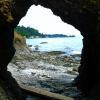Art and the social filter
By asomeshwarFebruary 2, 2015 - 23:33

My mouth is a fire escape.
The words coming out
don’t care that they are naked.
There is something burning in there.”
-Andrea Gibson
Serendip is an independent site partnering with faculty at multiple colleges and universities around the world. Happy exploring!

My mouth is a fire escape.
The words coming out
don’t care that they are naked.
There is something burning in there.”
-Andrea Gibson

Looking back over some of readings, there are many ways to begin developing an “ecological curriculum.” My responses to the theory we read were varied. While I appreciated Morton’s attempts, an ecological curriculum isn’t just open, engaged and infinite, it has to be grounded. Maniates “Teaching for Turbulence” perhaps struck me the most because above the others he focused on actual actions that could be taken, and his metaphor seemed helpful. I’ve started thinking through how I might shape something ecologically.

I struggled a bit with finding a sit space that felt right. I initially thought I would sit outside, either in Taft Garden or Morris Woods. I quickly realized, however, that as much as I stare in wonder at the fluffy white snow, I can't stand to be in it if I'm not walking somewhere. I wandered the campus for a bit after this, looking for a space that was still connected to outdoors, but without actually being outdoors. In the end I decided on Collier Library in Park Science Building. I walk past the library each day going to class and its impossible to miss the lovely glass atrium on the front of the building. I realized I have never been into this atrium, though, and only had a vague idea of how to actually get in there.

The Relationship Between the Migrant Worker and the Earth
In these first few weeks, I have taken a particular interest in the roles that race and ethnicity play in one’s perception of and interaction with the environment, nature, outdoors, etc., such as in Evelyn C. White’s autobiography Names We Call Home: Autobiography on Racial Identity and the article The Multicultural Approach to Ecopsychology by Carl Anthony and Renee Soule. That having been said, for this first paper, I would like to write about the relationship between the Latin American migrant workers in the U.S. and the fields in which they work.

It was interesting to me this idea that landscapes must fit within people’s comfortable definitions of what they are meant to consist of.
to me this idea that landscapes must fit within people’s comfortable definitions of what they are meant to consist of.

There are 3 particular readings that I have enjoyed thus far in class. These readings include: “The Ecological Thought” by Timothy Morton, “Sick of Nature” by David Gessner, and “The Land and Language of Desire” by Suellen Campbell. I believe these three articles share a similar and positive/ opportunistic view point about ecological thinking. Morton wrote about how ecology shows us that all beings are connected and that the ecological thought is the thinking of interconnectedness and coexistence. I also think some points (e.g. “‘Nature’“is an artificial construct” (pg.11)) in the article contradict the overall premise of what he is trying to say about ecological thinking.
When reading the two articles, “How to Destroy a Public-School System” by Daniel Denvir and “Racial Bias in Pennsylvania’s Funding Public Schools” by David Mosenkins I thought it was interesting how the first focused on funding between public and private school systems meanwhile the second article focuses on how the funding is distributed within the public school systems. However what really struck me was how at the moment “Pennsylvania is currently one of only three states in the U.S.
It struck me today that the No Child Left Behind Act was based on poverty. Having grown up with it in existence I did not realize that the NCLB act was supposed to prevent poverty. Thinking about it now, I question whether or not forcing people to be in an enviroment that they do not want to be in is even the right way to go about things.
On one note, I do not see how lack of an education can improve matters of poverty but on another note, having read this article, the benefits of a higher education seem not to exist.
The only path I see is having to create more jobs; an entirely new work force, but where exactly does that lie?

I appreciated the way the description of the different rocks that comprise Bryn Mawr's Campus and the history of Mill Creek demonstrated the direct connection between the economy, the environment, and safety. Due to increased flooding, many of the mills in Mill Creek were destroyed, which was a diverse industrial site that put many out-of-business.
It was interesting to learn about some of the advantages and disadvantages of hydropower. People had to make accomodations depending on the height and flow of the water. The article explained the immense power of water to destroy industries, carve valleys, be a sufficient and effective source of energy, and determine the layout and construction of a town and a city.
"Even the education levels of welfare recipients are high"